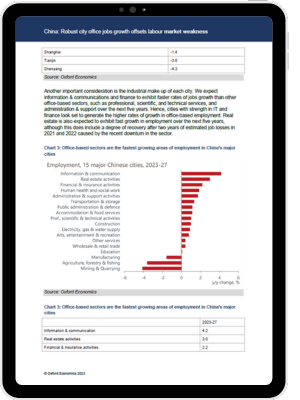Robust city office jobs growth offsets labour market weakness in China

China’s major cities will be primary drivers of office-based employment growth over the next five years, with 15 of the largest cities set to create more than a third of all new office jobs across the country. That is happening at a time when China’s overall level of employment has entered a period of long-term structural decline as the country grapples with its deteriorating demographics. The rise of office-based jobs is part of the country’s pivot into a more services-led economy.
What you will learn:
- In the five years to 2027, total employment in China overall is set to fall on average by 0.2% per year, whereas employment in office-based sectors is forecast to rise by 2.6%.
- The country’s major tech and finance cities such as Hangzhou, Shenzhen, and Guangzhou, lead the growth rankings of office-based employment. In growth terms, Shanghai and Beijing are weaker, but given their overall size, they are still expected to generate a high number of office-based jobs. Overall employment in those cities, however, is likely to fall given job losses in industrial sectors and the constraints on labour force growth applied by each city’s population caps.
- Some of China’s leading western and central cities, such as Xi’an, are forecast to compete with the country’s other major cities in terms of growth in office-based employment over the next five years as they grow in stature in higher-value services.
Tags:
Related posts

Post
The latest export from China is … deflation
We expect Chinese export price deflation to provide a helpful tailwind in the struggle to bring EM inflation back to target.
Find Out More
Post
Cross Asset: Closing our tactical long on gold, but we’re still bullish
The strength of the recent gold price rally has defied even our already bullish expectations and we think prices are vulnerable to a price consolidation in the short term. As a result, we close out our tactical long position on gold that we opened in October last year.
Find Out More
Post
How Asia’s supply chains are changing | Techonomics Talks
Global supply chains have continued to expand, despite talk of deglobalization and nearshoring. US and Japan have started to de-couple from China, but other G7 countries grow more dependent on Chinese inputs. Several "hotspots" are emerging across Asia with multiple winning formulas.
Find Out More